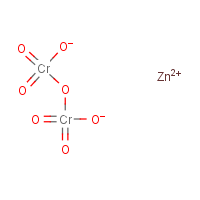Zinc dichromate
Agent Name
Zinc dichromate
CAS Number
14018-95-2
Formula
Cr2-H2-O7.Zn
Major Category
Metals

Synonyms
Chromic acid (H2Cr2O7), zinc salt (1:1); Dichromic acid (H2Cr2O7), zinc salt (1:1); Zinc bichromate; Zinc chromium oxide (ZnCr2O7); Zinc dichromate(VI); [ChemIDplus]
Category
Chromium Compounds, Inorganic
Description
Trihydrate: Orange-yellow or reddish-brown hygroscopic solid; Soluble in acids and liquid ammonia; [HSDB] Trihydrate: Red-brown solid; [MSDSonline]
Sources/Uses
Used as a pigment; [HSDB]
Comments
Solid will burn skin--slow to heal; [CHRIS] Trihydrate: May cause serious eye injury; May cause skin sensitization; [MSDSonline] See "Zinc chromate." See "Chromic acid." See "Chromium" and linked occupational diseases.
Biomedical References
Exposure Assessment
BEI
For chromium (VI), water-soluble fume: Total Cr in urine = 10 ug/L (increase during shift) or 25 ug/L (end of shift at end of workweek)
Bioaccumulates
Yes
TLV (ACGIH)
0.0001 mg/m3, as Cr(VI), inhalable particulate matter
STEL (ACGIH)
0.0005 mg/m3, as Cr(VI), inhalable particulate matter
PEL (OSHA)
0.005 mg/m3, as Cr(V1), Ceiling(OSHA) = 0.1 mg/m3, as CrO3 (for CAS 11103-86-9 and 37300-23-5)
MAK
0.1 mg/m3 (respirable fraction), 2 mg/m3 (inhalable fraction)-for Zn inorg. Compds
IDLH (NIOSH)
15 mg/m3, as Cr(VI)
Adverse Effects
Skin Sensitizer
Yes
Asthma
Yes
Hepatotoxin
Hepatoxic (a) from occupational exposure (secondary effect) or (b) in animal studies or in humans after ingestion
Nephrotoxin
Yes
Dermatotoxin
Skin burns
IARC Carcinogen
Established
NTP Carcinogen
Human carcinogen
ACGIH Carcinogen
Confirmed Human
Diseases, Processes, and Activities Linked to This Agent
Diseases
Occupational diseases associated with exposure to this agent:
Processes
Industrial Processes with risk of exposure: